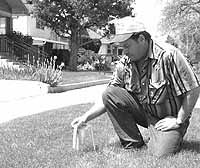| Marlon Winger, from the Utah State Extension serivce tests a lawn. Sod health is an important factor in keeping a lawn beautiful. Despite the fact that it seems lawns last forever, grass life can be worn down by a number of factors. |
To sod or seed? That is the question. It turns out that both have their advantages and drawbacks. A conversation with Van Cline, Ph.D., Agronomist for reveals a few tips to help homeowners choose.
Hands down, the fastest and most hassle-free way to create a lawn is with sod.
“If you need instant lawn, sod is the way to go,” says Cline. “But establishing a lawn from sod that stays vigorous for years to come requires more work than the average homeowner might think. Seeding is just as good or better if done correctly.”
The key to success for both methods of lawn installation lies in preparing the area that’s being seeded or sodded. Prepare the planting bed with a good rooting medium. Cline recommends a minimum of eight to 10 inches of healthy soil.
“A deep, well aerated planting bed encourages good vertical root growth. And a healthy root system translates into great looking turf.”
Healthy soil does not mean hauling in new soil unless absolutely necessary. More times than not existing soil is fine if it’s well aerated and well drained.
Having soil tested is a good idea. County extension service experts are a great resource to help determine what type of soil treatments may be necessary.
Laying sod is best done in the spring or fall when temperatures are moderate. Laying sod should be avoided in the heat of mid-summer or late in the season. New sod must have a period to establish roots before winter. Sodding no later than one month before the first frost is a good rule of thumb.
“The key to success with sod is establishing it properly,” says Cline. Sod rolls come with such a small portion of the roots attached, usually only about � inch of the soil layer. If the root system doesn’t establish well, the quality of the turf will gradually deteriorate over a period of a few years.
Once the roots have taken hold and the sod layer can’t be picked up,the lawn should be aerated. Cline recommends renting an aerator or contacting a lawn care professional for this service.
According to Cline, the best time to seed is late summer or early fall.
“You’ll have less competition from annual weeds since most don’t germinate after mid summer and growing conditions are perfect for seedling establishment.”
Once the seed bed has been prepared, choose a seed mix that is right for the specific conditions. A local nursery or county extension service are great resources for information on soil conditions and new turf establishment from either sod or seed.
Here are also some tips for established lawns.
If a lawn suffers from acute soil compaction, rampant weed problems, heavy thatch, or nutrient and organic matter deficiencies, the owner may want to remove their existing turf and replant their lawn. That’s a big job, but like a new roof, a new lawn will last a long time. There are four ways to replant a lawn: by applying seed, planting either sprigs or plugs, or laying sod.
Seeds are applied to a new lawn as discussed previouslyexcept that they are applied to soil from which all the turf has been removed.
Sprigs are typically planted by machine over large lawns; in small areas, they can be planted by hand. Sprigs consist of cut-up lengths of underground or aboveground runners, called rhizomes or stolons, upon which there are typically 2 to 4 joints, or nodes, from which the new grass blades emerge. Sprigs can be broadcast and then pressed into the soil or planted in shallow furrows.
Plugs–round or square pieces of sod that measure about 2 inches across–are planted in holes that are evenly spaced throughout the lawn. After several months, the grass plants from the plugs spread and fill in the gaps.
Sod is available in carpetlike sheets that are usually about 3/4-inch thick, 1-1/2 feet wide, and about 6 feet long. Pieces should be laid perpendicular to a slope in a staggered pattern, as one would lay bricks.

